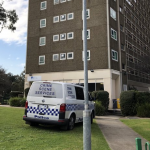Food being delivered at the Flemington public estates. Image: Margaret Simons.
Doing ‘hard lockdowns’ better COVID-19 Issues Alerts
Doing ‘hard lockdowns’ better
COVID-19 ISSUES ALERT
High-density living can be a potential incubator for COVID-19. The recent need for a ‘hard lockdown’ of large public housing estates in North Melbourne and Flemington exposed this risk all too clearly.
But any apartment block or residential facility with lots of people living in close quarters and sharing common facilities (lifts, foyers, car parks, laundries, etc) presents similar challenges.
If public health experts again deem a ‘hard lockdown’ of this type of accomodation necessary, then so be it. We are not public health experts and we don’t quibble with their advice.
But we must learn from what happened in Flemington and North Melbourne.
Here are five things that must be taken into account as part of any future ‘hard lockdown’:
 |
1. Clear communicationEvery resident facing a ‘hard lockdown’ deserves to know:
This information must be communicated in a timely manner and in plain language, not legalese. It must also be available in all relevant languages and in formats that are fully accessible for people with disabilities, including documents suitable to screen readers, Plain English versions, etc. The first people learn about a ‘hard lockdown’ of their community must be from a clear piece of direct communication—not a news bulletin or a police siren.
|

|
2. Fewer cops‘Locked down’ facilities are not crime scenes and residents are not criminals.The involvement of police should be kept to an absolute minimum. Extra challenges arise in places with residents from refugee, Aboriginal, Torres Strait Islander or migrant backgrounds. These communities are used to being overpoliced and subjected to racism. A large police presence unnecessarily escalates tensions and complicates the delivery of public health measures.
|
 |
3. More nurses and community workersCOVID-19 is a public health crisis. Responses need to prioritise keeping people healthy and well. That means responses led by nurses, public health officials and community health services. It also means providing immediate access to healthy food, opportunities for fresh air and exercise, mental health support and medication. Planning for the provision of these necessities must be done early—not as an afterthought. It’s not a good outcome if people avoid COVID-19 but their overall health and wellbeing suffers.
|
 |
4. Identify and meet people’s individual needsLike any community, people in high-density accommodation have different needs. Some people will have a disability. They might need help to shower, or to meet their sensory needs outside. There will be single parent families, people with food allergies or special dietary needs, people with pets needing walks. Some people will need medicine, or pharmacotherapies, or emergency dental care. Before any ‘hard lockdown’ commences, authorities must consider: How will people get the specific support they need, in a timely way? Will support workers and medical professionals have access and equipment so they can get in and help?
|
 |
5. Trust and empower local residentsCommunities know themselves better than anybody. They should be trusted, to the maximum extent possible, to regulate their own affairs during a ‘hard lockdown’. Authorities should develop a plan to genuinely and meaningfully include local communities and organisations in planning, service delivery and communications from the very start.
|
—
A series of personal stories about the pandemic, life in isolation and Victorians’ hopes and fears for the future.
All these stories are Creative Commons, meaning you can reproduce them with attribution.
READ STORIES

